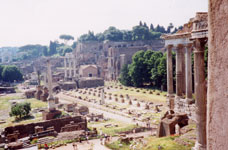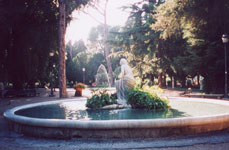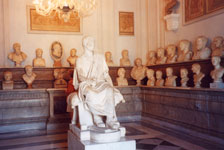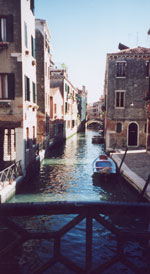Ancient Roman Tour
of ITALY

Prepared for Ms. Miller's Latin
II class
(grades 10-12)
Ancient Roman Tour
of ITALY

Prepared for Ms. Miller's Latin
II class
(grades 10-12)
Introduction
Ancient Rome fell with the empire some 1500 years ago...or so historians tell us. However, many vestiges (see etymology) remain from that great conquest, proving that all of ancient Rome is not necessarily dead (nor is Latin, the "dead language"!). For the next couple of weeks, we will explore the monuments, museums, and scenery of Italy's Roman empire.
For this project,
students will select a topic from the ones outlined in the "Procedures"
section and form research groups. Each group will be comprised of
4-5 students. In these groups, the students will examine several
aspects of the "ancient remains" in modern Italy, using English, Italian,
and Latin sources. After all the research has been compiled, each
group will present their information to the class in a technologically-enhanced
format (e.g. powerpoint, webpage, video, etc.). Following the presentations,
each student will prepare a "tour itinerary" of the top ten locations he/she
would visit on a trip to Italy.
Objectives
Sunshine State Standards
Foreign Language
FL.B.1.4.4
-identifies
and discusses artistic expressions and forms of the target culture.
FL.B.1.4.5
-identifies
and discusses target-language writers and their works and assesses their
influence not only on the products of his or her culture, but also on other
world cultures.
FL.C.1.4.1
-conducts
research on a topic of interest from an academic discipline using a variety
of target-language sources.
FL.C.2.4.4
-uses target
language sources to obtain information about a hobby, sport, or topic of
personal, community, or world interest.
Procedure
Part I:
(Duration: 2 weeks)
Select a
topic from the ones I have described below. When you have decided
on an area of research which interests you (and yes, this needs to be a
topic you find personally fascinating!), form a group with at least three
other members. For the next two weeks in class, I will give each
group time to do research at various stations in the classroom. I
have three computer stations for internet research, of which, one will
be slated for Italian reference, one for English reference, and the last
for Latin reference. I will also have two non-computer station set
up with travel guides, maps, advertisements, and any other helpful resources.
Additionally, I will allow a "scout" member of each group to collect extra
reference, as needed, from the school library.
You will
be examining the literatures that deal with your research areas.
As expected, you will work with the Latin texts, but for a further stretch,
you will be looking at English and Italian texts as well. DO NOT
WORRY!! I will assist your research and will be available to answer
your questions and help with the tougher parts of translation. The
main emphasis of your research is on historical background. I want
to know, for example, who used to own Pincio Gardens in ancient Rome?
And what romantic poet used to meditate there in the 1870's? I think
you will enjoy the tidbits you unearth, and I look forward to hearing you
share your research with the class.
The topics
are outlined as follows:
1. Monuments
 |
The Roman Forum,Colliseum, Temple of Vesta, Parthenon, Circus Maximus, Tarpeian Rock, Trevi Fountain, Piazza Navona, Temples A- B- and C, Vatican, Protestant Cemetery, Maosoleum of Augustus, etc. |
*Choose 5 monuments to investigate.
2. Scenery
|
Some suggestions: Borgouiese Gardens, Medici Gardens,
Pincio Gardens, the Orange Park, the Rose Garden,
|
 |
3. Museums
and Churches
 |
Vatican Museum, Capitoline Museum, Church of "Sant Andrea dell Frate," Uffici (in Florence), Church of the Cappucin Monks (Church of Bones), the catacombs, Church of the "Santi Apostoli," etc. |
*Choose 5 from museums/churches.
4. Italian
cities outside Rome
|
Florence,
|
 |
*Select 4 cites to study.
When all
groups are assembled, choose the specific items your group wishes to study,
including and extending the suggestions I've provided above. I do
not mind some overlap, but I also want to make sure that all topics are
covered.
Here is a list of links to some
of the internet research sites that we will use:
1. The
Perseus Latin Library - contains hundreds of texts, in Latin and English
2. Labyrinth
Latin Library - resources galore,in Latin and English
3. Fictional
Rome - info about historical fiction set in ancient Roman times
4. Online
Reference Book - list of fiction for students of history
5. Link
to Ancient Rome - customs, culture, literature, religion, etc.
6. Rome:
Literary Resources - links to more Latin texts
7. Ancient
Rome: Images and Pictures - just what it says
8. Roma
interactive - direct search for museum holdings
9. Famous
Painter.Com - info on Michelangelo's time in Medici gardens
10. Basic
Italian - resource for Italian language studies
11. Roma
Online - an Italian site with lots of info on customs, history, tours
*And many more!
Part II:
As mentioned
above, your group will be responsible for presenting your research to the
class. I will expect a 15-20 presentation in a technology-enhanced
format. You may use powerpoint, video, webpage, or other multimedia
forms of presentation. Handouts are not required, but would be appreciated.
REMEMBER,
you are teaching the class, so be mindful how you present your research.
The class will use these presentations as a guide for completing their
itineraries. Also, be excited! You are tour guides trying to
sell each other specialized package trips to Italy. You are the expert!
Part III:
Due: 1 week after the last presentation.
|
Construct an itinerary of the
"Top 10" stops for your own Italian tour, integrating what you learned
from the class presentations. Present your itinerary as two parts--
include 1. a map with each location marked and numbered, and 2. a word-processed
document listing each location and describing its historical significance.
Additionally, for each stop on your tour, answer the following question:
|
 |
THE END.
|
Created by Angela B. Miller Classics senior University of Florida |
 |
|
|
|
Technology Rich Lesson
prepared for EME 4406
18 April 2002